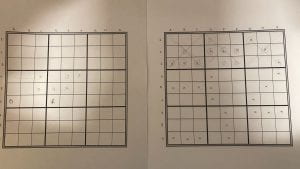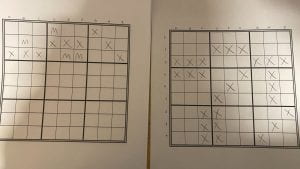
Recent Posts
Intervention: Uncle Roy Koopa
My project is “Uncle Roy Koopa: All Around You,” a scavenger hunt that takes place in Mario Maker 2.
Players enter the level as normal, but will quickly realize that the only way to beat it is to enter a 5-digit code they don’t know. In a floating comment, the character “Uncle Roy Koopa” (based on the koopaling from the original Mario games) explains what’s going on. He says, “The code is at my other home. QX8-G82-2WG.” The sequence he gives is the ID for a completely different level. Players will then have to play that level, explore obscure parts of the map, and find *another* floating comment that states which level to try next. All in all, there are three levels the player has to explore before getting the final code.
The point of this game is to disrupt the way people play Mario Maker levels. In general, the community treats levels as very disposable, playing a level quickly from start to finish, and then forgetting about it. This is very unfortunate to me, since it reflects the increasingly apathetic way that people are engaging with art. Instead of being a meaningful experience that makes people think or feel, people are just consuming and moving on. I wanted to see if I could break that trend by turning a Mario Maker level into a more mysterious, longer-term experience.
The biggest inspiration for this level (probably obvious) was “Uncle Roy: All Around You.” While this game doesn’t have the social aspect of that experience, it does have the element of interacting with the world differently than we normally would. Instead of treating our cities as a simple, start-to-finish experience (go to the store–then we’re done), the game encourages people to find wonder and intrigue by exploring areas of their city they probably don’t normally visit. Because of that, I thought it was a great intervention model to follow.
This game has changed a little bit since I first came up with the idea. The biggest difference from before is that it used to be a social experience, where users would leave comments to pledge that they’d “be there for someone they don’t know.” That isn’t really practical in Mario Maker 2, since the active player base isn’t what it used to be size-wise, and so forming a lot of pairs like the original “Uncle Roy” can’t really happen.
Link to a video of the level: Link
Thoughtless Objectives
Title: Thoughtless Objectives
Inspiration:
- Watching the video that Jen and Derek put on with the man deciding what the woman should do and what decisions they should make
- Then thought about how I write stuff and how others influence my decisions when I’m writing
Supplies:
- Notebook/Journal (preferably on the cheaper side)
- A pencil or pen
Setup:
- There will be one person with a notebook(the notetaker)
- Next, there is at least 1 person (a person) who will get the notebook and decide what they want to change in it (They can either overwrite, erase, nothing, or be creative).
- There will be a neutral judge that will decide whether the objective is complete or if the objective is possible
Before Playtest:
Gameplay:
- The notetaker will write down what they want for two minutes while the person tries to influence their decision (by talking, moving, or anything besides physical interaction)
- The notetaker’s goal is to write/draw something that is beneficial for them. Without letting, the person’s influence get to them
- When the person gets the notebook, they have 30 seconds to do whatever they want to the notebook. (obviously not destroy the notebook or make it unusable)
- The person’s goal is to either have the notetaker actively write down their influences when they are writing or make the notetaker give up.
- There is no end unless the person’s goal is fulfilled or the person gives up
After Playtest:
Gameplay:
- The person will give the notetaker an objective (it has to be something that can be written down into the journal and feasible in 2 min)
- The notetaker has two minutes to achieve the objective (while the person tries to influence, distract etc)
- If the judge decides the notetaker completed their objective then they get 1 point and the roles switch (players can choose who they want to be)
- If the judge decides the notetaker did not complete the objective then the person has 30 seconds to mess up whatever the notetaker wrote (they can not make the notebook unusable up to judge’s decision)
- The person gets a point if the notetaker gives up
- The first to whatever how many points wins!
Objective based-goals:
write/draw everything on a gudetama poster
Write down page 132 of the book in its entirety
Write the exact number of candies that are in that pile on the floor, as the pile exists right now, without removing any candies
Write down 120 words, each of character length greater than 3, and each word has to be unique. Shorthand is not permissible, and the 120 words refers not to “120 words” but rather to the action of writing down all 120 words.
Write down the hex color code of this blanket

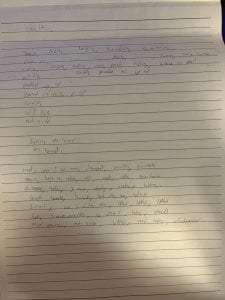
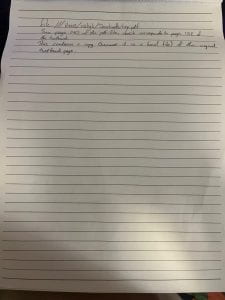

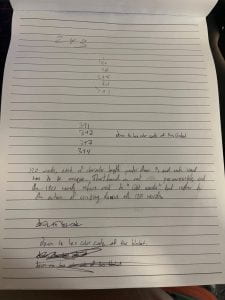
Artist statement:
The original meaning of the artwork was to mock the simple task of writing a schedule, detailing a plan of action, doodling etc by showing the power random people have seemingly over us and changing/influencing what we want even though it’s our journal. I’m exaggerating my critique on how our minds seemingly function, and questioning why we let people dictate our actions. But as the playtest went on, the meaning of the game changed. It became more of critiquing unrealistic tasks that we are given on a daily basis. Everything from school to home life, it’s all a crumpled mess because doing it all seems impossible. We work so hard to reach a goal only for our work to be rendered useless or something comes up that delays us from accomplishing that goal. The new version of “Thoughtless Objectives” is supposed to be representative of this feeling. Being the notetaker, you are under an immense time crunch, trying your hardest to finish the task while the person is actively trying to sabotage you. The person only wins by making the notetaker give up; this was intentional in order to hit home the idea that there is no real reason for making things difficult for a person besides satisfaction in a person’s misery. Although the task given is supposed to be possible, the person can dance on the line between extremely difficult and impossible. As I witnessed in my playtests, I had a person tell the notetaker to count all the candy on the floor (being over 400 candies). While the notetaker did attempt it, they ultimately failed. On a personal level, there are times where I feel like everything is just conveniently against me. With every mistake I make or extra time I take, the dumber I feel amongst my peers. The more I feel this way the more I listen to others rather than myself. Even with this project, I feel like the real intervening was the playtesters’ feedback vs my original idea.
Intervention: The Northeastern ARG
Overview:
My intervention project was a Northeastern ARG, or ‘alternate reality game.’ These typically involve using real-world locations or settings and creating a fictitious narrative for players to follow. A lot of times these games involve puzzle-solving, and thus a mysterious and intriguing element is almost tradition for these types of experiences. I decided to follow suit and create a short puzzle game that would take place on campus, with players tasked to uncover data about a supposed “Northeastern Conspiracy” that is hidden somewhere on campus using clues posted in different locations to track it down.
Rules:
Two locations near to each other on campus were identified, and this is where the ‘clue’ pages were left. I wanted to keep the number of clues needed to solve the puzzle to an absolute minimum so that students passing by would potentially be more interested in playing the ARG as it would be over very quickly. The ‘A’ page contained a key with letters corresponding to numbers and symbols:
| 1 | 2 | 3 | 4 | 5 | 6 | 7 | 8 | 9 | ! | ^ | $ | % | – | * | ( | ) | & | + | [ |
| a | r | s | g | t | h | y | l | r | f | o | m | e | d | i | n | c | u | b | k |
Meanwhile, the ‘B’ page contained the location of the data itself, but encoded using this key:
!2^$ 56% 97-%9 6188 3*4( 5&9( 9*465 1(- 6%1- 1)2^33 56% 359%%5 5^ 56% 5188 42133 12^&(- 56% 3*-% ^! +%621[*3 56% -151 *3 6*–%( *( 56% 42133
In addition to the piece of the clue, the two types of pages would each list the location of the other type of page, meaning that regardless of which page was found first a player would know where they needed to go to make their end of the puzzle work. Put together, the two clues would reveal the following sentence: “From the Ryder Hall sign, turn right and head across the street to the tall grass around the side of Behrakis. The data is hidden in the grass.” Just as the clue states, the ‘data’ (which itself was a piece of paper with text on it) was hidden outside in a weatherproof bag for players to eventually find.
The paper itself contained an absurd description of the process of paying tuition to the school, described in a way that made it sound like criminal activity. However, it was revealed at the end that this was all a joke and part of my ARG to avoid any unintentional distress or people taking my game more seriously than it was meant.
Artists Statement:
Certain in-class examples, such as the Barbie Liberation Organization, created scenarios where a false ‘narrative’ was created by intervening in a real-life space. In that instance, a fiction that the toys themselves were rebelling against their company was created using the setting of real stores in a manner that interacted with real people. While my ARG was more interactive than this- I was still inspired to try and use the ARG to facilitate my own fictional narrative. I wanted to create a tongue-in-cheek parody of the idea that there was a conspiracy going on at Northeastern that poked fun at some of the most common student complaints about the University. In this way, it acted as a very small form of protest while simultaneously being an absurd narrative that somehow there was an organization dedicated to uncovering the secrets that players could interact with throughout the game.
Unfortunately, in my attempts to set it up on campus, I was stopped by student employees at Northeastern both times I tried to put up my posters at my planned locations- unfortunately preventing me from seeing the results of my intervention as I had originally intended. In hindsight, I should have planned to put them in locations that were more free for students to put up posters but I am inherently limited by what I’m allowed to do on campus- and it is possible this project wasn’t feasible given the time I would need to coordinate it with the school. I was also concerned about player participation in my game, and whether or not anyone would take the time to do it. I think had I planned a wider setup of my posters this and the previous problem could have been alleviated.
Photos:
Here are some photos of me attempting to put up the posters and hide the clue:

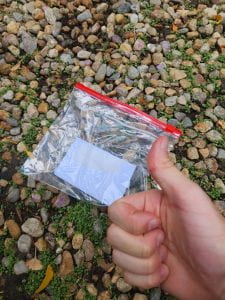
Artwork 2: Appropriate – The King’s Cards
The King’s Cards – by Tim Doyle
The Rules:
- 2-4 Players allowed
- Play a game of Uno, only the objective is to collect as many cards of the same color by the end of the deck
- By the end of the game, whichever colored card you have the most of is your designated color, and you gain 1 point per card you have
- All special cards maintain their properties (skip cards, reverse, wild cards, etc)
- If by the end of the game two or more players have been collecting the same color, they all lose
- If by the end of the game you have cards not belonging to your color, you must subtract points from your score
I originally centered the game around the rules of King’s Cup, where whichever card is drawn dictates some action the players have to complete, but those rules didn’t transfer over very well to the context of this class. I was suggested to try and use Uno cards to make the game more intuitive, by using the numbers and colors to dictate certain actions and make it easier to remember what it is the player should do, but that was still too complicated. After my first play test outside of class, I found that it was still difficult and confusing to use rules dictated by King’s Cup using cards that weren’t from a standard deck. Eventually, I decided to scrap the rules of King’s Cup entirely and chose to appropriate the rules of Uno instead. I wanted my rules to emphasize division and segregation, so I used the different colors as the centerpiece surrounding my appropriation. The original game of Uno already plays with this idea of using a card’s color to dictate the player’s options, where you can only play one color card per turn unless you meet some specific scenario, but I decided to turn up the use of the colors in my appropriation. Instead, you are forced to collect as many of the same color as you can.
The play tests were simple and easy, as the game of Uno is not very difficult to comprehend. What I noticed is that it was difficult to gather a large amount of cards because of the nature of Uno, but that was alright in the end because you technically didn’t need a lot of cards to win the game.
The game isn’t made to be super balanced, but it was crafted to be a more artistic take on the use of the cards themselves. I drew a lot of inspiration from some of the works in Dada, and more specifically the simple creativity that the artists used in their works. My favorite art pieces from the book were very derivative of the original piece, where they heavily used the source material in their appropriated work, focusing more on putting a simple and creative twist on the work instead of completely warping it. This is what my game has in common, where the game fundamentally feels the same as a regular game of Uno, but the simple change in win conditions completely changes how the game is actually played by the players.
Super Mario Bros.: Just-Like-You-Remember-It Edition!
The Game:
Super Mario Bros.: Just-Like-You-Remember-It Edition! features five levels of memory-deteriorating fun!
Built upon “Super Mario Bros” by Github user Gold872
…which is recreating some old video game from the 80s or something.
Artist’s Statement:
If you’ve ever played the game Super Mario Maker, or its inventively titled sequel Super Mario Maker 2, you’ve perhaps encountered the many remakes of Super Mario Bros.’s first level, 1-1. These are plentiful and unavoidable when playing this game online. Some people twist the level, adding traps and fire bars everywhere. Some remakes are perfectly accurate, but most aren’t. Many of these remakes get small details in spacing wrong. Some of them miss entire parts of the level. As time passes, which details of the games we play are we still able to remember?
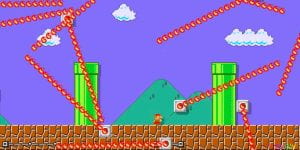
I’m not sure I remember it like this… (pictured: Super Mario Maker 2)
This game project was primarily inspired by the plunderphonic works of Daniel Lopatin (AKA Oneohtrix Point Never, AKA Chuck Person), James Leyland Kirby (AKA The Caretaker), William Basinski, and various artists in the vaporwave genre, as well as the appropriation works of the Dada movement.
Daniel Lopatin in 2010, under the pseudonym Chuck Person, released a limited-run cassette tape of 80s pop songs looped, slowed down, and distorted into what he coined “eccojams”. By taking somber lyrics of songs out of context, Lopatin creates a haunting reinterpretation of these once-hits. These eccojams are heavily concerned with the idea of memory. They feel like distant memories of one part of a song, randomly getting stuck in one’s head years later. Lopatin re-released several of them on his audiovisual project “Memory Vague”. He approaches the idea of memory deteriorating at the end of the tape’s first side, where it gets more and more distorted and noisy until the original sample has been fully drowned out by a pulsing harsh noise.
Another artist even more concerned with the deterioration of memory, specifically in relation to neurodegenerative diseases like Alzheimer’s, is Leyland Kirby, who produces music as The Caretaker. The Caretaker’s most well known albums, “An empty bliss beyond this world” and “Everywhere at the End of Time”, are based on a study where people with Alzheimer’s were able to recall associated memories from the music of their youth. Both albums feature 1920’s music scavenged from record stores, looped and echoed into distant memories. “Everywhere at the End of Time,” Kirby’s final project as The Caretaker, is comprised of six stages reflecting the progression of Alzheimer’s disease. Kirby’s work is often compared to William Basinski’s “Disintegration Loops”, an album of tape loop experiments where the tapes continually deteriorate as they’re played.
The Dada movement saw many artists (although they themselves at the time may have rejected the term, time and Wikipedia have come to know Dada as an art movement) appropriating found objects, twisting their meaning and purpose into new subversive works. While these artists were very interested in specifically using found objects, I am mostly interested in the way these repurposed objects lose or alter their meaning. When Kurt Schwitters repurposes machine parts, old newsprint, or bus tickets, they lose their ability to function as intended. Using these appropriated works in collage puts them in a new context and assigns them new meaning. When Marcel Duchamp creates a readymade statue out of a bicycle wheel or a urinal, he assigns it new meaning as a work of art. I love this idea of assigning new meaning to existing things through selection and transformation.
These projects got me thinking about applying the idea of memory deterioration to games. Artists like Basinski use the decay of physical artifacts to create their art, but digital games don’t degrade in the same way. I wanted to capture the idea of a poorly-remembered level, such as that seen in Mario Maker 1-1 remakes. I wanted to loop one piece of a game into infinity, like Daniel Lopatin or Leyland Kirby did with their music. I wanted the entire thing to collapse in on itself by the end like the Disintegration Loops, because at some point, everyone’s memory runs out.
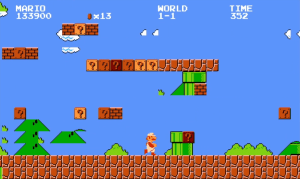
I originally wanted to use a game other than Super Mario Bros., but it was the easiest to find an accurate recreation of to modify for this project. It also worked well to work off of a game with wide familiarity, since the game should ideally be concerned with a level the player actually does remember. I took the structure of 1-1 and created five levels from it.
The first level is exactly 1-1, recreated perfectly, in a fairly accurate recreation of the original game.
The second level is slightly off. The spaces between key moments of the level have been altered, and powerups may be in different locations. The music has been slowed down slightly. This level is meant to represent misremembering the small details of the level design, as many Mario Maker recreations do.
The third level begins repeating key structures of the level, or forgetting some entirely. The music does something similar, repeating portions of the iconic overworld theme and skipping occasionally.
The fourth level repeats the beginning of the level over and over again. I consider this the “eccojam level”, as one moment is repeated again and again. The music is inspired by the second eccojam on the tape, called “angel”. It loops one section of the song, speeding it up and down in a disorienting manner. One moment it resembles the original bouncy track, and the next it briefly slows to a chiptune dirge.
The fifth and final level represents the final deterioration of a memory of this level. The level design and background elements repeat and glitch in nonsensical ways, only vaguely resembling the looping beginning of the level. The music is slow and drawn out, randomly pausing for large amounts of time and twisting into sounds the NES would not be able to replicate. Eventually, the iconic features of the level vanish, and the empty land soon gives way to an uncrossable abyss, as the memory eventually fades away.

At some point, everyone’s memory runs out.
Fun-Sized Party TRPG
The link of the intial game lies here: https://docs.google.com/document/d/1Yp_ar11r5YD4KgCzbWW-UJo9-Me2pTxPWS2h1F9NL3A/edit
I tried my best to ritualize the procedure of the game in an Onoesque way that simplifies everything to the extent that the game is almost unbearably simple, and provided very straightforward and malleable insturctions for each and every step, as an Ono piece would radiate that sort of energy.
The procedure of playing this game extended into crazy and unrestricted interpersonal gameplay, which was my designated plan. That sort of freedom of interpretation took away some constraints of a traditional TRPG and made a fun experience that is easily understood and replayed. I did hope that the extensive usage of the d6 would also bolster that accessibilty and create a party game that would help people enjoy instead of feel constraint in almost any sense. I tried and the rhytm of the game was highly malleable, which also resonates with how simplicity was the central theme of Ono’s works.
Despite liking the sense of this artwork, I find that I would need to be better with people to have the best fun in this game.
A Drumming Party Game!
Originally, I wanted to appropriate the movie Blue Giant which came out recently, its about teenagers who want to play jazz and one wants to become the best jazz musician in the world. This movie has an incredible soundtrack and I wanted to appropriate it for this project so that people could feel that excitement of playing together as the teenagers did in the movie and the same way I have in previous bands. I started out with a concept about jazz music where each player would be playing a different instrument and after learning the play their instruments in the gamified way, they would be able to play together. Upon presenting this idea to my class, the lack of enthusiasm made it clear to me that my idea for the mechanics was uninteresting and the concept too confusing so, I scrapped it and started over. At its core, I wanted people to enjoy making music together when I remembered that during a vacation I went on, the staff of where we were staying, gathered us for a drum circle night of playing and dancing and I remember, despite never having played with these people, you could still have fun however in a much more casual way than jazz typically is. So, for my in class playtest, I brought in a multiplayer rhythm game where players learn to play quarter, eighth, and sixteenth beats. Once learning all these types of rhythms, they had an opportunity to play together. It was during this playtest that I realized, many people who have never experienced reading rhythm notation may struggle with this game so I simplified it for the final version.
In the final version, after each time they learned a new “skill” ie. a quarter beat, eighth, silent or free square, players each got a part and had an opportunity to play together! This minimized the pain of learning each new type of rhythm because players had more opportunity to play together than the previous iteration which kept players more engaged.
I think if I were to continue working on this game, I would add in the sixteenth beats next for players that want a challenge and also allow each player to pick different difficulties so more complex rhythms can be created for those with more experience, and simpler rhythms for players that are new to drumming so they are not overwhelmed.
While I don’t think that my appropriation of drumming circles here quite parallels the readings about artists during the dada era, I think in the general concept of artists stealing parts from things that inspire them and want to use those things to create some emotion in their audience or share their perspective, we are similar.
View the final project here! –>https://docs.google.com/presentation/d/1LicYVpAYDTwsX63m1Ydw8YuLkEHwAmsqyqm5RDUIaz0/edit?usp=sharing
First draft of project party game–> https://docs.google.com/presentation/d/1EhXa9rFqUOjQU7nrzzBMya-cqFzBVC-i0yMby5fO33A/edit?usp=sharing
playtest notes–> https://docs.google.com/document/d/1AVBal4TWfIEXbFqE30LrdEDK59G3CI8ElFbTVnnq1RY/edit?usp=sharing
Tic-Tac-Toe Where?
Game Rules:
Preparations
- 4 sudoku tables labeled A – I horizontally, 1 – 9 vertical
- Each player marks 3-in-a-row on each 3-by-3 grid on the board as a means of winning, Make sure your opponent cannot view your board.
Playing
- On each turn, players would “attack” the board to see where the enemy has placed their markers on the blank board. When attacking, announce to your opponent the grid you are attacking.
- The opponent must tell whether the attack hit or missed. If the attack missed, the player that attack may go again.
Goal
First to find 3-in-a-row of the 3 x 3 square of the opponent will win.
Artist Statement
Initially, I started with a Yoko Ono inspired work where the tic tac toe game would create an infinite game of tic-tac-toe. I wanted to create a distinctive art piece through a game with the only added rule being “add a line anywhere on the page after you play your move in tic-tac-toe”. The games became messy and interesting as people were forced to think outside of the box about their next move until realizing that they would never win. The best part was seeing people coming to this realization and seeing the way that their strategic play-style from before changed into pure chaos. It was a creative spin to the game however, it wasn’t as climatic as I expected it to be. (Playtest result see below)
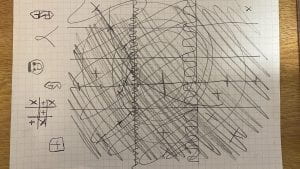
As a result, I decided to do a mashup of different games together to create a intensive game of tic-tac-toe using a sudoku board and the gameplay of battleship to create a fun and different spin to the game. Initially with this iteration, I started with a basic tic-tac-toe board, but I feel like the game would be too brief for players to feel the fun before it is over. Thus, I adopted the idea of using the sudoku board as it is comprised of 9 tic-tac-toe boards together while also creating a larger 3 x 3 board.
Overall, I felt that artists during the DADA movement were having fun with their work while trying to iterate on previously-created works of art. Iterating on my own idea reminded me a lot of Marcel Duchamp as he has appropriated his own works so many times. In a way, iterating and improving upon an idea could be appropriation as I had changed the ideas and made it into my own. Like artists during the DADA movement, I had fun trying to think of various ways to iterate and add more to a simple game of tic-tac-toe that I’ve known all my life.
Headbandz Appropriation
In a world of conflict, the Dada movement developed as a daring response to the war, embracing the bizarre and senseless. The chaos of World War I provided fertile ground for the Dadaists’ revolutionary spirit, as they used art to transcend reality’s darkness into a realm of absurdity, satire, and amusement. Using inspiration from this, I appropriated the board game “Headbandz” to craft an experience that serves as a playful counterpoint to the somber undertones of the Dada movement, infusing it with a sense of light-heartedness and pure enjoyment.
My journey began with a desire to harness the Dadaist spirit of rebellion and absurdity, transforming “Headbandz” from a game centered around objects into an ensemble of diverse video and board/card games. Rather than appropriating the tension of war, I aimed to infuse a sense of lightheartedness and fun into the experience. Through the reinterpretation of cards, I have provided a platform for players to escape the weight of reality and immerse themselves in a world that they are familiar with, by reminiscing about some of the most popular games in recent times.
The game works similarly to how “Headbandz” originally works, but instead of guessing random objects players are guessing popular games within recent times. Since this is a games course, I thought appropriating the “Headbandz” game to be about video/board/card games would be fun. Since I wanted the game to fit the lighthearted feel, I tried to think of popular games that everyone would know so players could reminisce once they figured out what their game was. I play-tested it in class as well as in the final iteration and everyone seemed to enjoy guessing and talking about popular games that they played growing up. I got some suggestions about making it a bit faster since it took a decent amount of time to play so I decided to have two game modes, one for a quicker game and one for a longer version. The quicker one would be timed and each player would have 30 seconds to ask as many yes or no questions about their game to try and figure it out. Once the 30 seconds was up, it would move to the next person and repeat the process until someone guessed their game correctly. For the longer version, there would be no timer involved and each player would ask a yes or no question about their game. If the answer to their question was a yes then they would keep asking questions until the answer was no and then it would be the next person’s turn. This process would repeat until everyone guessed their game correctly.
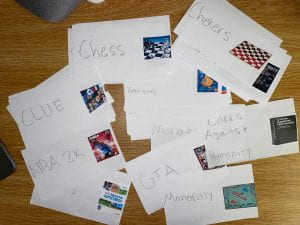
Texas Holdem -but with action card!
To play the game, first, you need to know about a regular Texas holdem. Texas Hold’em’s a card game with four times to bet. Everybody gets two cards, and there are five more cards on the table. You can choose to drop out, match the bet, or raise during the betting times. The point is to make the best hand you can with your cards and the ones on the table. The person with the best hand wins. The dealer button moves around the table, and your goal is to win chips from the others.
But in this version:
Alongside the regular number cards, there are also “action cards” mixed into the deck, in order to add a twist to the gameplay.
Players have the freedom and are encouraged to use these action cards at any point during the game. when a player decides to play an action card, they must draw another card from the deck, to keep the same number of cards in their hand.
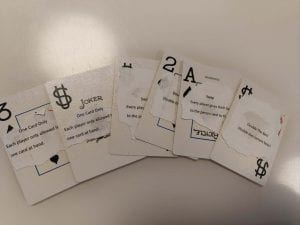
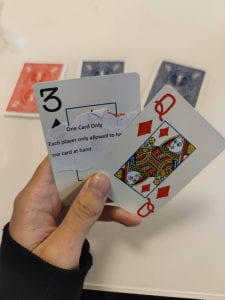
Betting:
Also, in this version, you are not betting with chips. Instead, you are betting with the parts of your body. For example, If I have a good hand, I may raise the bets to 1 eye. At the end of the round, the one with the strongest hands can keep his/her bets, while the other players can’t use one of his eyes for the rest of the game. The player loses the game when the player is unable to continue playing with no eyes or no fingers.

Artist statement:
This project is inspired by the appropriations in the Dada movement. This project reflects the Dadaist approach of taking existing objects and recontextualizing them to create unexpected art. There were lots of appropriations about chess during the movement, for example, Yoko Ono’s Play It by Trust, Takako Saito’s Sound Chess, and Spice Chess. My initial idea was to combine poker with UNO, so the cards dealt were UNO instead. But when I searched “Poker * UNO” on Google, I found someone in this class had a similar idea and already posted it in 2016. Therefore instead of UNO, I combined it with action cards. Those action cards brought more randomness and strategies to poker. Players in this game can also use action cards at any time, altering the gameplay in unexpected ways. This is also a kind of appropriation as Dada art often featured unexpected and irrational elements.
